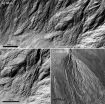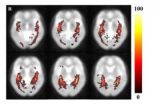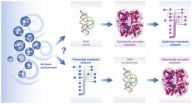(Press-News.org) ANN ARBOR, Mich. — There's a civil war going on inside every one of the 37 trillion cells in your body. Now, University of Michigan scientists have uncovered how your cells keep this war from causing too much collateral damage.
On one side of the battle: your "regular" DNA, which provides the day-to-day instructions for life. On the other side: tiny bits of rogue DNA that hide like spies between genes in your own DNA. From time to time, these rogue bits of DNA spin off a copy of themselves and "jump" to another DNA location – often causing harmful mutations when they land.
How our cells fight off the effects of these rogue DNAs, called LINE-1 retrotransposons, has remained a mystery. But in a new paper published in the open-access journal eLife, scientists from the University of Michigan Medical School and Howard Hughes Medical Institute and colleagues have captured the action like battlefield reporters.
They zeroed in on the defensive activity of an enzyme called APOBEC3A – and showed that it can cause mutations within the LINE-1 retrotransposons as they jump to new locations. This prevents subsequent invasions into other areas of DNA.
This defensive strike sends out a signal to other defense forces inside the cell, which neutralize the jumping gene and sweep away the destroyed copy.
The findings not only help explain a mystery of the body – they also may help in the development of cancer drugs. That's because other APOBEC enzymes cause cancer-related mutations – a kind of "friendly fire" that makes these enzymes a potential target for new drugs.
The new findings about APOBEC3A's ability to squelch LINE-1 activity could mean that blocking APOBEC3 with new cancer drugs might carry consequences.
John Moran, Ph.D., the U-M and HHMI geneticist who led the work with Sandra Richardson, Ph.D., says the new finding gives scientists the first proof of a hypothesized defense strategy.
"It's often hard to see what normally happens during an efficient process that occurs inside our cells," he explains. "But by blocking the process that would normally clean up the evidence of this interaction, we can start to see what is going on."
Dangerous junk
Our cells may each contain as many as 500,000 copies of LINE-1, says Moran, the Gilbert S. Omenn Collegiate Professor of human genetics and professor of internal medicine at U-M and an HHMI research investigator.
LINE-1 is part of the so-called "junk DNA" that makes up half of our genetic material – but the purpose of "junk DNA" is unclear.
Most LINE-1 copies lay dormant, but a few dozen active copies reside in each cell. LINE-1 retrotransposons can activate and jump, making them dangerous junk.
In fact, LINE-1 alone may cause one in every 250 disease-causing mutations in humans.
So, the "junk" moniker doesn't really fit, says Moran – though he admits we are probably stuck with this label. He and his team have studied LINE-1 and other jumping genes for years, working with colleagues from the University of Pennsylvania and the Salk Institute, who are co-authors on this paper, and, in previous studies, with colleagues at Duke University.
Fighting fire with fire
In addition to fighting LINE-1 jumps that can cause mutations, APOBEC enzymes also fight off certain viruses. In fact, scientists first discovered these enzymes when observing how human cells fight off infection by HIV, the virus that causes AIDS.
Just like HIV, LINE-1 spreads throughout our DNA by making an RNA copy of its genetic sequence. Then, the RNA is copied back into a new LINE 1 copy that can slide into a new location in our DNA -- a process called retrotransposition.
In this new paper, the researchers show that LINE-1 has one important point of vulnerability. When the new DNA copy peels away from the RNA, an APOBEC3A molecule can attach and change some of the "letters" or base-pairs (rungs on the DNA ladder) in the DNA sequence. Specifically, it changes the "C" bases to "U" bases. The presence of those U bases triggers the cell's cleanup mechanism to come in and dismantle the new copy of the rogue DNA.
In other words, APOBEC3A preempts a potential mutation by LINE-1 jumping, by itself causing a mutation in the new LINE-1 copy that the cell then destroys. But APOBEC3A can pose a mutation danger to the rest of our DNA – which means our cells must strike a balance between a vigorous defense and the danger of friendly fire.
This kind of intracellular "immunity" may have been raging since the beginnings of life on earth, Moran speculates. LINE-1 contains the code for a molecule called reverse transcriptase – the kind of molecule that would have been crucial when higher life forms started to evolve and use DNA instead of the less stable RNA to carry genetic information.
Moran and his colleagues will continue to study the importance of the APOBEC family of enzymes in fighting the effects of jumping genes.
They hope to study APOBEC's importance in fighting off mutations early in the development of embryonic life, and in the development of the eggs and sperm that carry our genes to the next generation. Now that they have shown how this defense mechanism works in cultured cells, they hope to study the importance of LINE-1 jumping and the defenses against it in specific diseases.
INFORMATION:
Reference: eLife publish on acceptance, http://dx.doi.org/10.7554/eLife.02008 END
A civil war inside our cells: Scientists show how our bodies fight off 'jumping genes'
First evidence of how cells block mutation-causing activity of junk DNA may have significance for cancer drug development
2014-04-25
ELSE PRESS RELEASES FROM THIS DATE:
Traces of recent water on Mars
2014-04-25
The southern hemisphere of Mars is home to a crater that contains very well-preserved gullies and debris flow deposits. The geomorphological attributes of these landforms provide evidence that they were formed by the action of liquid water in geologically recent time.
Evidence of liquid water
When sediment on a slope becomes saturated with water, the mixture may become too heavy to remain in place, leading to a flow of debris and water as a single-phase unit. This is called a debris flow. Debris flows on Earth often cause significant material destruction and even human ...
Tsetse fly genetic code sequenced
2014-04-25
Scientists at the University of Liverpool have been part of a ten-year project which has successfully sequenced the genetic code of the tsetse fly – making major advances in disease control possible.
Tsetse flies are unique to Africa and can infect people bitten by them with sleeping sickness, a disease which damages the nervous system and is fatal if untreated. This kills over 250,000 people each year.
Traditional methods of control such as releasing sterile males, trapping and pesticide spraying are expensive and difficult to implement. Sleeping sickness can also ...
Quantitative volumetric analysis of the optic radiation in the normal human brain
2014-04-25
The optic radiation is a dense fiber tract that emerges from the lateral geniculate nucleus and continues to the occipital visual cortex. Especially, the optic radiation is an important fiber structure that conveys visual information from the lateral geniculate nucleus to the primary visual cortex in the occipital lobe. Current studies have focused on the anatomical characteristics of optic radiation fiber tracts in individual brains and on comparisons of the anatomical characteristics of the optic radiation fiber tracts between patient and control groups. Therefore, no ...
Climate change: Don't wait until you can feel it
2014-04-25
Washington, D.C.— Despite overwhelming scientific evidence for the impending dangers of human-made climate change, policy decisions leading to substantial emissions reduction have been slow. New work from Carnegie's Katharine Ricke and Ken Caldeira focuses on the intersection between personal and global impacts. They find that even as extreme weather events influence those who experience them to support policy to address climate change, waiting for the majority of people to live through such conditions firsthand could delay meaningful action by decades. Their findings ...
Reconstructed ancient ocean reveals secrets about the origin of life
2014-04-25
HEIDELBERG, 25 April 2014 – Researchers from the University of Cambridge have published details about how the first organisms on Earth could have become metabolically active. The results, which are reported in the journal Molecular Systems Biology, permit scientists to speculate how primitive cells learned to synthesize their organic components – the molecules that form RNA, lipids and amino acids. The findings also suggest an order for the sequence of events that led to the origin of life.
A reconstruction of Earth's earliest ocean in the laboratory revealed the spontaneous ...
Metabolism may have started in our early oceans before the origin of life
2014-04-25
The chemical reactions behind the formation of common metabolites in modern organisms could have formed spontaneously in the earth's early oceans, questioning the events thought to have led to the origin of life.
In new research funded by the Wellcome Trust, researchers at the University of Cambridge reconstructed the chemical make-up of the earth's earliest ocean in the laboratory. The team found the spontaneous occurrence of reaction sequences which in modern organisms enable the formation of molecules essential for the synthesis of metabolites such as amino acids, ...
Apps, Touch Tablets Bringing Mobility to Chemical Research Industry
2014-04-25
The formula for success in the chemical research industry is beginning to take shape outside of the traditional laboratory setting.
Touch-enabled software and tablets are transforming chemical researchers' workflows, bringing time-savings and mobile capability to professionals who are used to desktop computers and the pen-and-paper mentality.
For example, the updated Mobile Reagents scientific app from Eidogen-Sertanty now offers a Windows* 8 version for touch devices built on Intel architecture, and allows mobile access to more than 17 million chemical product variations ...
3rd Twin's New Single, '3rd,' 'Leaks' Online Ahead of Release of Underground Mixtape
2014-04-25
The wait is over there has been a leak of 3rd Twin's new hit from the highly anticipated "50 artist 50 states" Underground Mixtape, slated for release May 9th. 3rd Twin, Portland, Oregon's best lyricist is back with a vengeance with "3rd" "leaked" online Sunday night.
"3rd" #1 wit a bullet 50 artist 50 states is 3rd Twin at his best displaying his clever word play and powerful punchlines. "3rd" is a definite anthem and club banger and great follow up to his first single "Future in ya Stuntin," which caused quite the stir on the internet, creating a huge buzz as he shot ...
Charleston Culinary Tours Presents a Special Taste of the Market on May 15th at 6:30pm on Anson St. to Celebrate our Civil Servants, Military, Hometown Heroes and Local Community Leaders.
2014-04-25
Charleston Culinary Tours presents a special Taste of the Market on May 15th at 6-8:30pm at the Palmetto Carriage lot on Anson Street by the City Market that celebrates local civil servants, military personnel, hometown heroes and community leaders. For devotion to duty and sacrifice of self, they will receive a discounted admission of $5 (saving $5) and other giveaways with uniform or ID badge. Additionally, Charleston Culinary Tours is offering 10% off on culinary tours and 20% off any Mixology Tour in May, June or July with sign up at the Taste of the Market. The mission ...
Jordan Older signs Major League Soccer's (MLS) Chivas USA mifielder Marvin Iraheta to King Sports Management
2014-04-25
Midfielder Marvin Iraheta joined Chivas USA during the team's 2012 pre-season on January 24 arriving from the Cosmos Academy West. In August 2011, Iraheta traveled to England with the New York Cosmos to square off against club powerhouse Manchester United, match that drew over 74,000 fans to the Old Trafford Stadium.
Iraheta was named Player of the Year for the 2009-2010 season of the U.S. Developmental Academy U-17/18. He was born in Departamento de Cabañas, El Salvador and moved to the United States in 2008. In his first year he was named US Academy Player of the Year, ...
LAST 30 PRESS RELEASES:
How sound moves on Mars
Increasing plant diversity in agricultural grasslands boosts yields, reducing reliance on fertilizer
Scientists uncover a new role for DNA loops in repairing genetic damage
AI chatbots can effectively sway voters – in either direction
Study reveals 'levers' driving the political persuasiveness of AI chatbots
'Tiny' tyrannosaurid, Nanotyrannus lancensis, was a distinctive species, not juvenile T. Rex
Scientists capture first detailed look inside droplet-like structures of compacted DNA
Return of the short (tyrant) king: A new paper by Dinosaur Institute researcher shows Nanotyrannus was not a juvenile T. Rex
New study confirms Nanotyrannus holotype was distinct species from T. rex
Carnegie Science names Michael Blanton 12th Observatories Director
From mice to humans in five years: Microglia replacement paving the way for neurodegenerative disease therapies
To treat long COVID, we must learn from historical chronic illnesses, medical researchers say
Volcanic eruptions set off a chain of events that brought the Black Death to Europe
Environmental science: Volcanic activity may have brought the Black Death to medieval Europe
Public trust in scientists for cancer information across political ideologies in the US
Adverse experiences, protective factors, and obesity in Latinx and Hispanic youths
Researchers identify bacterial enzyme that can cause fatal heart conditions with pneumonia infections
Single enzyme failure found to drive neuron loss in dementia
Sudden cardiac death risk falls in colorectal cancer, but disparities persist
From lab to clinic: CU Anschutz launches Phase 1 clinical trial of promising combination therapy for resistant ovarian cancer
Renuka Iyer, MD, named new Chief Medical Officer for National Comprehensive Cancer Network (NCCN)
New organ-on-a-chip platform allows the testing of cancer vaccine efficacy in aging populations
No, we don't need more and more data about nature. We need more people to use the data
Research explores effect of parental depression symptoms on children’s reward processing
Phonetic or morpholexical issues? New study reveals L2 French ambiguity
Seeing inside smart gels: scientists capture dynamic behavior under stress
Korea University researchers create hydrogel platform for high-throughput extracellular vesicle isolation
Pusan National University researchers identify the brain enzyme that drives nicotine addiction and smoking dependence
Pathway discovered to make the most common breast cancer tumor responsive to immunotherapy
Air pollution linked to more severe heart disease
[Press-News.org] A civil war inside our cells: Scientists show how our bodies fight off 'jumping genes'First evidence of how cells block mutation-causing activity of junk DNA may have significance for cancer drug development


